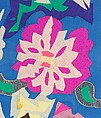Textile
Design House Myrbor French
Attributed to Sarah Lipska Polish
Not on view
This object is from a collection of sample embroideries, which was originally owned by Morris de Camp Crawford, editor of Women's Wear Daily, who collected objects which told the story of fashion and fabric history. Included in this collection was a group of textiles which illustrated what American and French designers and manufacturers were using. According to Crawford's book The Ways of Fashion, the work of Polish artist Sarah Lipska (1882-1973) was represented in this collection. Lipska is an enigmatic figure, who is known to have worked with Leon Bakst as a set and costume designer for the Ballets Russes, and later in the 1920s as a fashion designer in Paris at 4 rue Belloni, and finally as a sculptor. Extant examples of her work are rare. Although only a few pieces in the Brooklyn Museum collection bear a label or a signature, others bear hallmarks of her work, such as a distinctive form of whip stitching on appliqué work, unusual abstract motifs, and Cubist-inspired patterns.
The brilliant coloration and graphic impact of this piece strongly connects it to both the work of Sarah Lipska and the Myrbor couture house. The quality and character of the work is also reminiscent of work done by both Lipska and her colleague Natalia Goncharova for the Ballets Russes. The whip stitching used to apply the appliqués on to the brilliant blue chiffon is a hallmark of Lipska's designs, and is also seen on other Myrbor designs in the Brooklyn Museum collection (see 2009.300.3246a, b, 2009.300.3247 and 2009.300.3248). This piece also bears a tag which designates a connection with the couture house. The stipple marks that indicate the placement of appliqués suggest that this was a work in progress, and provides insight into the design process for embroidery.
Due to rights restrictions, this image cannot be enlarged, viewed at full screen, or downloaded.
This artwork is meant to be viewed from right to left. Scroll left to view more.




